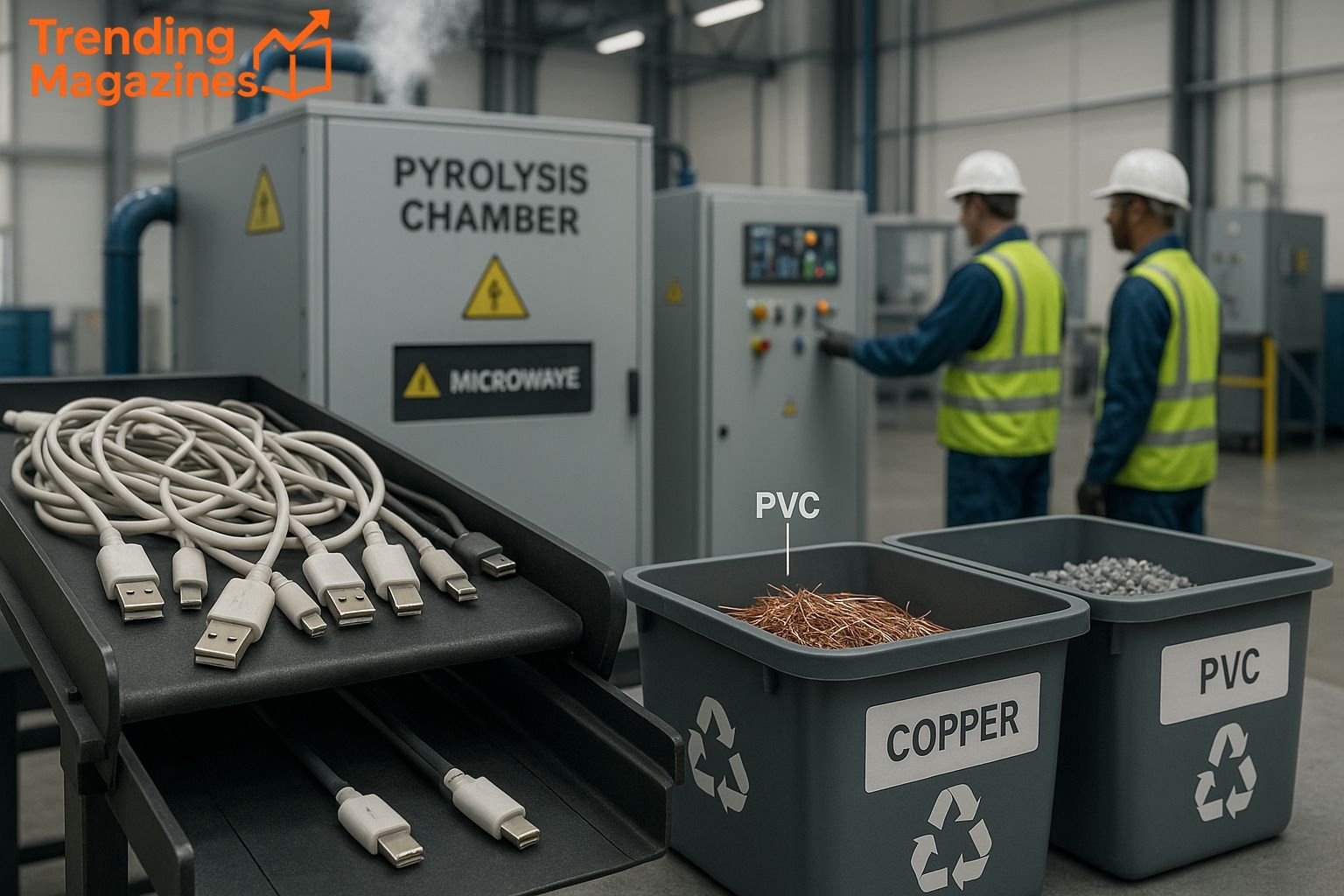Introduction
Electronic waste is rapidly becoming a global environmental burden, particularly in the form of discarded charging cables and electronic connectors. Recycled USB cables, often viewed as minor contributors to landfill waste, hold untapped potential for material recovery. One of the most promising technologies for extracting valuable metals like copper from these cables is pyrolysis. By applying thermal decomposition in a controlled environment, pyrolysis enables efficient separation of copper wire from its PVC insulation and other components without emitting harmful pollutants, when managed correctly.
Summary Table: Key Issues and Opportunities
| Challenge/Opportunity | Details |
| Volume of E-waste from USB cables | USB cables are often discarded due to obsolescence and poor durability. |
| Hazardous materials involved | Includes PVC, flame retardants, lead, cadmium, and PCBs. |
| Environmental risks | Toxic emissions from informal disposal methods. |
| Recovery opportunity | Copper wire can be reclaimed using microwave-induced pyrolysis. |
| Legal compliance | Aligns with E-waste (Management) Rules 2016 in India. |
Understanding the USB Cable Waste Stream
The proliferation of electronic gadgets has drastically increased the volume of cables entering waste streams. USB cables, though small, contribute significantly to electronic waste (e-waste). Their internal structure typically comprises polyvinyl chloride (PVC) insulation encasing copper wire conductors. Many of these are discarded before the end of their actual life, contributing to unnecessary depletion of natural resources.
Composition and Associated Risks
- PVC insulation: Known for its flame retardant qualities but emits toxic substances upon improper disposal.
- Copper wire: Valuable and highly conductive, making it ideal for recovery and reuse.
- Additives: Often include lead, cadmium, chromium, and polychlorinated biphenyls (PCBs), all of which pose public health hazards.
Improper disposal methods particularly those seen in informal disposal facilities can lead to central nervous system damage, respiratory diseases, and severe environmental pollution through air and water contamination.
Pyrolysis as a Copper Recovery Technique
Pyrolysis is a thermal process that decomposes organic and composite materials at high temperatures in an oxygen-deprived atmosphere. It stands out from conventional combustion or incineration by limiting air pollutants while maximizing resource recovery.
Pyrolysis Mechanism in USB Cable Recycling
During the process, the PVC insulation undergoes thermal decomposition, producing volatile gases, chlorine recovery compounds, and carbonaceous residues. This breakdown exposes the copper wire, enabling its efficient separation and collection.
- Microwave-induced pyrolysis: Uses microwave radiation to heat materials internally and uniformly, enhancing efficiency.
- Nitrogen atmosphere pyrolysis: Prevents oxidation, preserves metal integrity, and supports chlorine and carbon black production.
Advantages of Using Pyrolysis
- No combustion: Minimizes harmful gas emissions.
- Retains copper purity: Important for industrial reuse.
- Produces carbon black: Can be used as a filler in rubber and plastic manufacturing.
- Supports hazardous waste management: Ensures safer handling of flame retardants and additives.
ALSO READ
Legal and Environmental Framework
Compliance with E-waste (Management) Rules 2016
As mandated in India, any organization or individual dealing with electronic waste must adhere to structured collection and disposal mechanisms. These rules also call for the establishment of authorized e-waste recyclers and designated collection points to ensure sustainable disposal.
Role of Authorized Recyclers
Authorized recyclers follow approved methods for material separation and copper wire recovery. These facilities employ reverse logistics for gathering end-of-life products, ensuring traceable and safe processing practices.
Environmental and Health Considerations
Dangers of Unscientific Handling
The use of open burning and acid leaching in informal setups leads to:
- Air and water pollution
- Long-term soil degradation
- Direct exposure to carcinogenic compounds
Benefits of Scientific E-waste Recycling
- Reduces pollution: Limits emission of hazardous substances like dioxins and furans.
- Conserves natural resources: Reuses metals, reducing dependence on mining.
- Promotes public health: Minimizes exposure to substances causing neurological and developmental disorders.
Material and Energy Efficiency
Pyrolysis Output and Energy Profile
USB cable pyrolysis not only recovers copper but also generates by-products such as:
- Carbon black: Usable in tire and pigment industries
- Gaseous fuel: Contains methane, ethylene, and hydrogen
- Char residues: Potential for energy reuse
The calorific value of PVC makes it a viable energy source when processed under controlled conditions. These outputs enhance the sustainability index of this waste-to-resource technology.
Infrastructure Needs and Technology Adoption
Current Gaps in Recycling Infrastructure
India faces challenges in scaling its recycling facilities, especially those capable of performing microwave heating of plastics and other non-conventional recycling methods. Existing recycling infrastructure often lacks the ability to handle cables efficiently.
Technological Requirements
- Industrial microwave pyrolysis reactors
- Gas scrubbing systems
- Automated copper wire separation units
Investment in these technologies ensures compliance with legal standards and enhances overall recycling efficiency.
Toward Digital Sustainability
Public Awareness and Responsibility
The responsibility of safe e-waste disposal lies not only with producers and recyclers but also with consumers. Many are unaware of secure e-waste drop-off options and continue to dispose of cables through household waste streams.
Role of Collection Points and Customer Care Services
Electronics brands must establish well-marked collection points, supported by customer care services that inform users about safe disposal methods. Public-private collaboration is essential for achieving better recycling outcomes.
Final Thoughts:
Copper recovery from recycled USB cables through pyrolysis is a scientifically robust and environmentally sound solution to a growing e-waste crisis. This method not only conserves resources and minimizes pollution but also aligns with global sustainability objectives. By embracing advanced recovery techniques and legal frameworks like the E-waste (Management) Rules 2016, stakeholders across the value chain from consumers to recyclers can support a cleaner, healthier future. Adoption of this technology must be backed by policy, awareness, and investment in infrastructure to ensure it becomes a cornerstone of modern waste management strategy.



